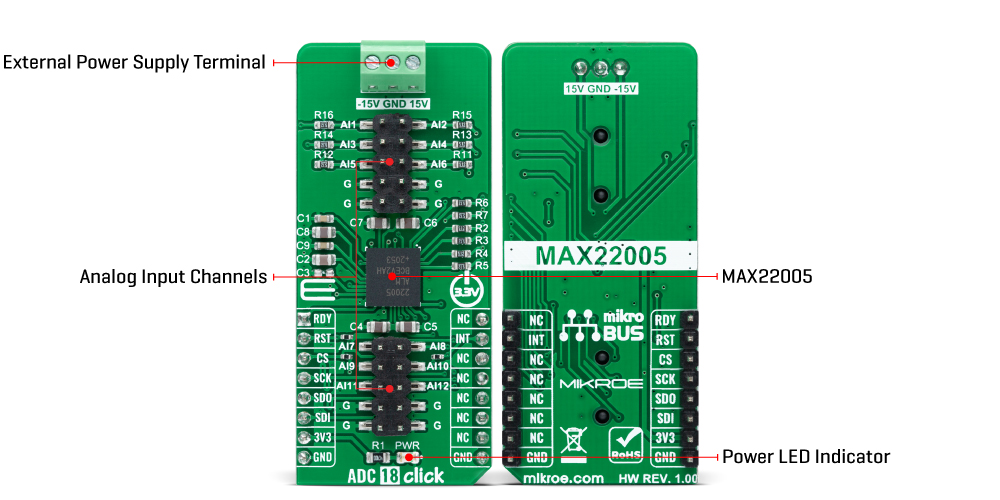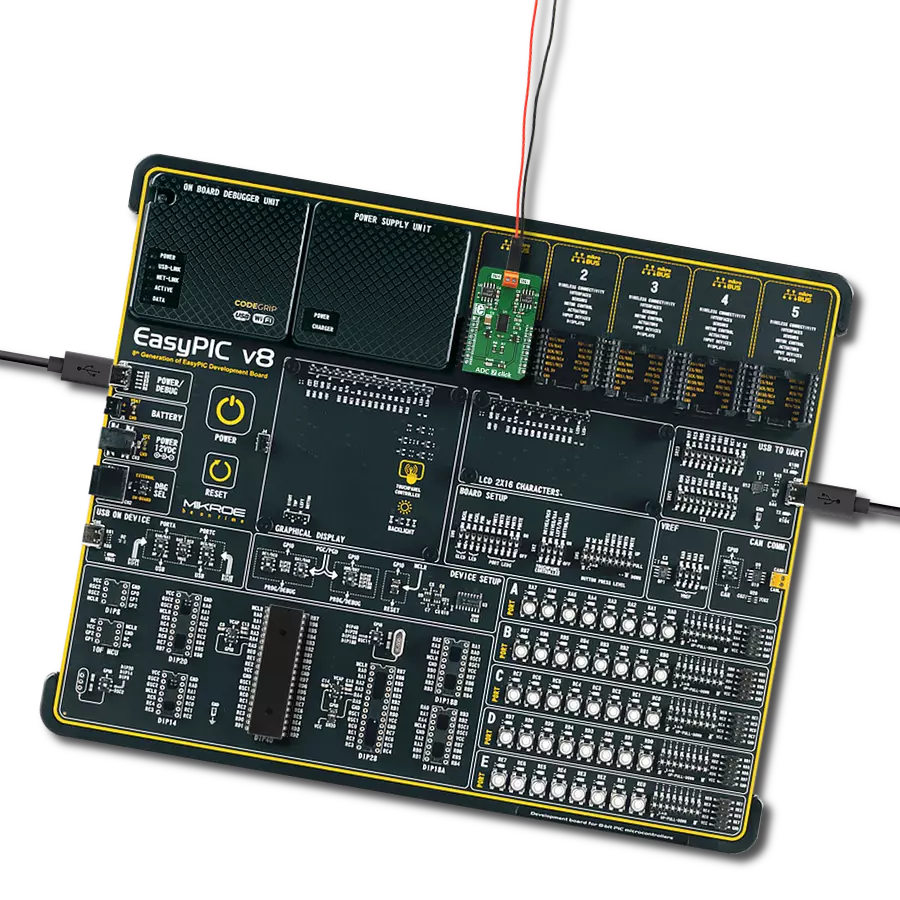Translate analog signals for data processing purposes
A
A
Hardware Overview
How does it work?
ADC 18 Click is based on the MAX22005, a high-performance twelve-channel analog-to-digital converter from Analog Devices. The MAX22005 has an integrated 24-bit delta-sigma ADC, input multiplexer, signal conditioning, and control logic block, allowing ADC to communicate with MCU through a high-speed serial interface. An integrated delta-sigma ADC is shared between all channels with an integrated 5ppm/°C precision reference. Using high-voltage, zero-drift input amplifiers, standard industrial analog input voltage ranges are converted to the ADC input voltage range. Input channels can be used as twelve single-ended, six differential, and up to eight multichannel configurable differential inputs. In total, the device supports up to 26 different configurations. The MAX22005 can also be configured as an analog-input
current-mode device using an external precision resistor per channel or configurable analog input using an external precision resistor and low-cost switch per channel. All input ports are robustly protected up to ±36V reverse polarity and ±2kV surge pulses without the need for TVS diodes and factory calibrated with a best-in-class system performance of less than 0.05% FSR Total-Unadjusted-Error (TUE) over temperature. ADC 18 Click communicates with MCU through a standard SPI interface and operates at clock rates up to 30MHz, for all configurations and information management and acquiring conversion results. In addition, it also uses several mikroBUS™ pins. An active-low reset signal routed on the RST pin of the mikroBUS™ socket activates a hardware reset of the system, while the INT pin on the mikroBUS™
socket represents a standard interrupt feature providing a user with feedback information. It also has an additional data-ready interrupt marked as RDY and routed on the AN pin of the mikroBUS™ socket, used to signal when a new ADC conversion result is available in the data register. This Click board™ can only be operated with a 3.3V logic voltage level. It also has an analog inputs external power supply terminal where it is necessary to bring ±15V to accept ± 10V inputs, whose full-scale range is ± 12.5V. The board must perform appropriate logic voltage level conversion before using MCUs with different logic levels. However, the Click board™ comes equipped with a library containing functions and an example code that can be used, as a reference, for further development.

Features overview
Development board
Nucleo 32 with STM32F031K6 MCU board provides an affordable and flexible platform for experimenting with STM32 microcontrollers in 32-pin packages. Featuring Arduino™ Nano connectivity, it allows easy expansion with specialized shields, while being mbed-enabled for seamless integration with online resources. The
board includes an on-board ST-LINK/V2-1 debugger/programmer, supporting USB reenumeration with three interfaces: Virtual Com port, mass storage, and debug port. It offers a flexible power supply through either USB VBUS or an external source. Additionally, it includes three LEDs (LD1 for USB communication, LD2 for power,
and LD3 as a user LED) and a reset push button. The STM32 Nucleo-32 board is supported by various Integrated Development Environments (IDEs) such as IAR™, Keil®, and GCC-based IDEs like AC6 SW4STM32, making it a versatile tool for developers.
Microcontroller Overview
MCU Card / MCU

Architecture
ARM Cortex-M0
MCU Memory (KB)
32
Silicon Vendor
STMicroelectronics
Pin count
32
RAM (Bytes)
4096
You complete me!
Accessories
Click Shield for Nucleo-32 is the perfect way to expand your development board's functionalities with STM32 Nucleo-32 pinout. The Click Shield for Nucleo-32 provides two mikroBUS™ sockets to add any functionality from our ever-growing range of Click boards™. We are fully stocked with everything, from sensors and WiFi transceivers to motor control and audio amplifiers. The Click Shield for Nucleo-32 is compatible with the STM32 Nucleo-32 board, providing an affordable and flexible way for users to try out new ideas and quickly create prototypes with any STM32 microcontrollers, choosing from the various combinations of performance, power consumption, and features. The STM32 Nucleo-32 boards do not require any separate probe as they integrate the ST-LINK/V2-1 debugger/programmer and come with the STM32 comprehensive software HAL library and various packaged software examples. This development platform provides users with an effortless and common way to combine the STM32 Nucleo-32 footprint compatible board with their favorite Click boards™ in their upcoming projects.
Used MCU Pins
mikroBUS™ mapper
Take a closer look
Click board™ Schematic

Step by step
Project assembly
Track your results in real time
Application Output
1. Application Output - In Debug mode, the 'Application Output' window enables real-time data monitoring, offering direct insight into execution results. Ensure proper data display by configuring the environment correctly using the provided tutorial.

2. UART Terminal - Use the UART Terminal to monitor data transmission via a USB to UART converter, allowing direct communication between the Click board™ and your development system. Configure the baud rate and other serial settings according to your project's requirements to ensure proper functionality. For step-by-step setup instructions, refer to the provided tutorial.

3. Plot Output - The Plot feature offers a powerful way to visualize real-time sensor data, enabling trend analysis, debugging, and comparison of multiple data points. To set it up correctly, follow the provided tutorial, which includes a step-by-step example of using the Plot feature to display Click board™ readings. To use the Plot feature in your code, use the function: plot(*insert_graph_name*, variable_name);. This is a general format, and it is up to the user to replace 'insert_graph_name' with the actual graph name and 'variable_name' with the parameter to be displayed.

Software Support
Library Description
This library contains API for ADC 18 Click driver.
Key functions:
adc18_set_active_channelThis function sets the active channel.adc18_start_conversionThis function starts the conversion with the selected data rate.adc18_read_voltageThis function reads RAW ADC value of previous conversion and converts it to voltage.
Open Source
Code example
The complete application code and a ready-to-use project are available through the NECTO Studio Package Manager for direct installation in the NECTO Studio. The application code can also be found on the MIKROE GitHub account.
/*!
* @file main.c
* @brief ADC18 Click example
*
* # Description
* This example demonstrates the use of ADC 18 Click board by reading
* the voltage from 12 analog input single-ended channels.
*
* The demo application is composed of two sections :
*
* ## Application Init
* Initializes the driver and logger, and performs the Click default configuration.
*
* ## Application Task
* Reads and displays the voltage from 12 analog input single-ended channels
* on the USB UART approximately once per second.
*
* @author Stefan Filipovic
*
*/
#include "board.h"
#include "log.h"
#include "adc18.h"
static adc18_t adc18;
static log_t logger;
void application_init ( void )
{
log_cfg_t log_cfg; /**< Logger config object. */
adc18_cfg_t adc18_cfg; /**< Click config object. */
/**
* Logger initialization.
* Default baud rate: 115200
* Default log level: LOG_LEVEL_DEBUG
* @note If USB_UART_RX and USB_UART_TX
* are defined as HAL_PIN_NC, you will
* need to define them manually for log to work.
* See @b LOG_MAP_USB_UART macro definition for detailed explanation.
*/
LOG_MAP_USB_UART( log_cfg );
log_init( &logger, &log_cfg );
log_info( &logger, " Application Init " );
// Click initialization.
adc18_cfg_setup( &adc18_cfg );
ADC18_MAP_MIKROBUS( adc18_cfg, MIKROBUS_1 );
if ( SPI_MASTER_ERROR == adc18_init( &adc18, &adc18_cfg ) )
{
log_error( &logger, " Communication init." );
for ( ; ; );
}
if ( ADC18_ERROR == adc18_default_cfg ( &adc18 ) )
{
log_error( &logger, " Default configuration." );
for ( ; ; );
}
log_info( &logger, " Application Task " );
}
void application_task ( void )
{
static uint8_t channel = ADC18_CH_AI1_SINGLE_ENDED;
if ( ADC18_OK == adc18_set_active_channel ( &adc18, channel ) )
{
adc18_start_conversion ( &adc18, ADC18_DATA_RATE_225_SPS );
// Waits for the availability of the conversion result
while ( adc18_get_rdy_pin ( &adc18 ) );
adc18_stop_conversion ( &adc18 );
float voltage;
if ( ADC18_OK == adc18_read_voltage ( &adc18, &voltage ) )
{
log_printf ( &logger, "Channel AI%u: %.2f V\r\n", channel + 1, voltage );
if ( ++channel > ADC18_CH_AI12_SINGLE_ENDED )
{
channel = ADC18_CH_AI1_SINGLE_ENDED;
log_printf ( &logger, "\r\n" );
Delay_ms ( 1000 );
}
}
}
}
int main ( void )
{
/* Do not remove this line or clock might not be set correctly. */
#ifdef PREINIT_SUPPORTED
preinit();
#endif
application_init( );
for ( ; ; )
{
application_task( );
}
return 0;
}
// ------------------------------------------------------------------------ END


































